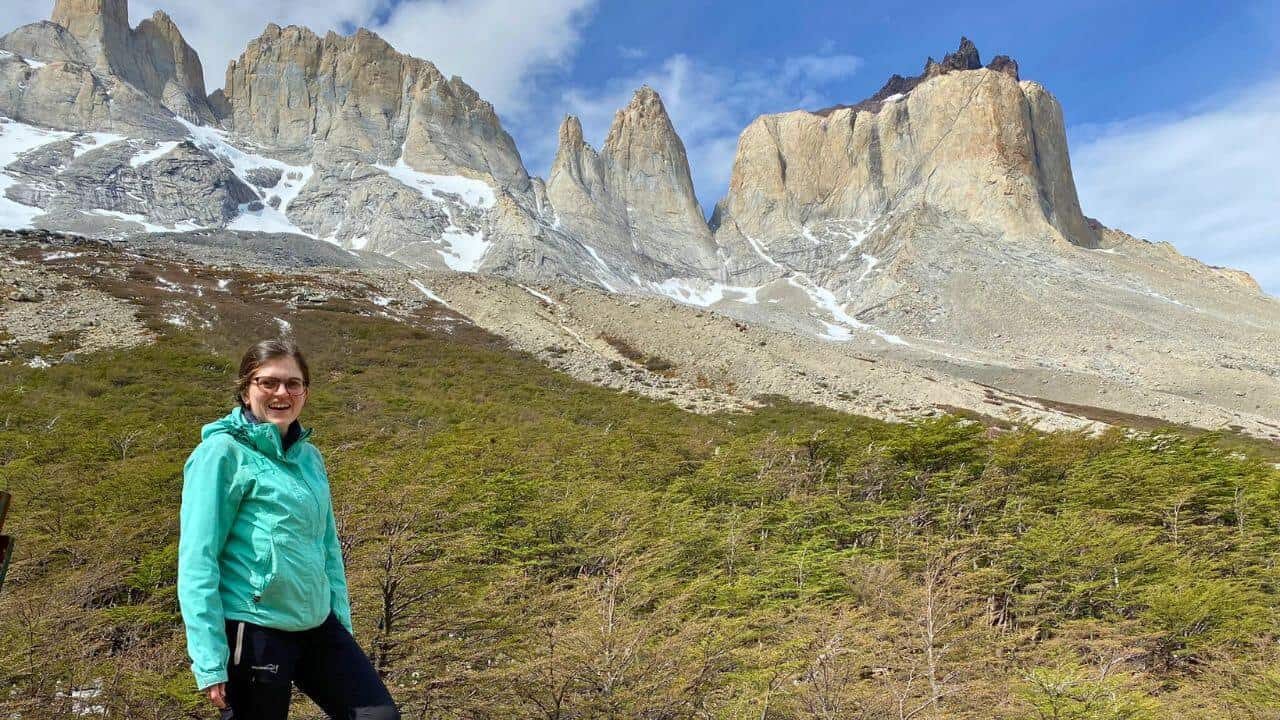Torres del Paine is one of those places that lives up to the hype, and then some. You’ve probably seen photos of jagged peaks, turquoise lakes, and massive glaciers, but being there in person is a completely different experience.
I spent nearly a week hiking through the park, and every day brought something new. Standing close to glaciers, walking among towering peaks, hearing the ice crack from Glacier Grey, and watching guanacos graze quietly.
Whether you’re planning a multi-day trek or just a couple of day hikes, Torres del Paine can be as challenging as it is breathtaking. The trails are well-marked, but the weather is unpredictable, and planning ahead is essential if you want to make the most of your time. Because all that beauty makes the park popular, and it’s hard to get spots on specific campsites.
That’s why you need this Torres del Paine hiking guide, where I’ll walk you through the best hikes, the practical tips I wish I knew before arriving, and how to plan the perfect adventure in the park.
Best Hiking Routes in Torres del Paine
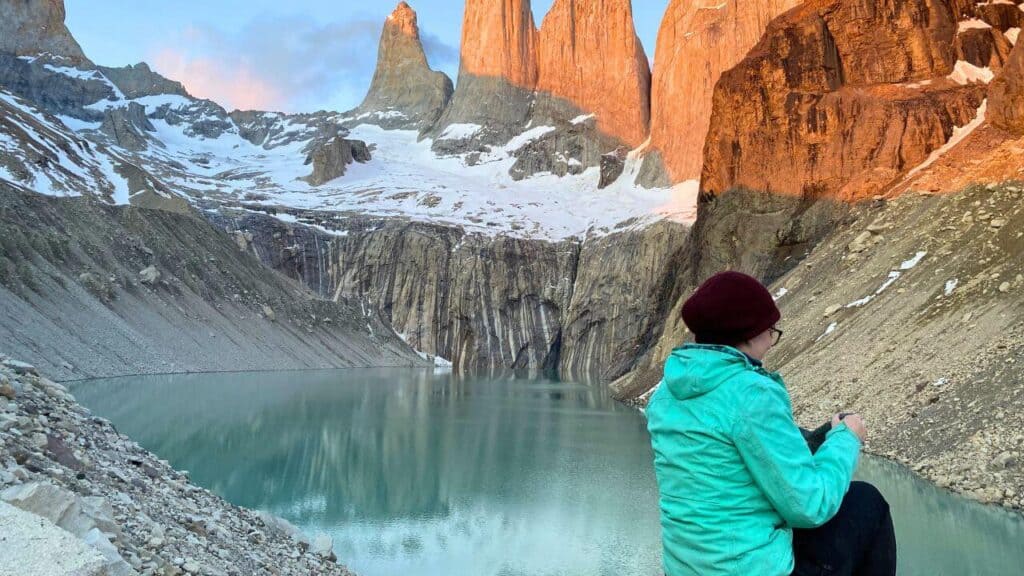
I spent five days exploring Torres del Paine, and even that barely scratched the surface. The park is huge, and every trail feels different. Some hikes take just a few hours, while others stretch over multiple days. The best way to experience it all is on foot, to see it up close.
From the W Trek through the French Valley to quieter trails near Laguna Azul, each hike offered something unforgettable. The key is planning: know what you want to see and make sure to take a little rest into account too. For most visitors, the multi-day treks (the W, O, and Q) offer the best way to see the best views. They vary in length, difficulty, and crowd size. Here’s what you can expect from each of them:
Multi-Day Hikes in Torres del Paine
The W Trek. The W Trek is the classic Torres del Paine hike, stretching roughly 50 miles (80 kilometers) over 3–5 days. I started early from the western trailhead, and every day brought a new highlight. Glacier Grey is jaw-dropping, and I spent an hour just enjoying the view at the French Valley. The Torres themselves are the grand finale: reaching the base at sunrise was exhausting but unforgettable. Every step is worth it.
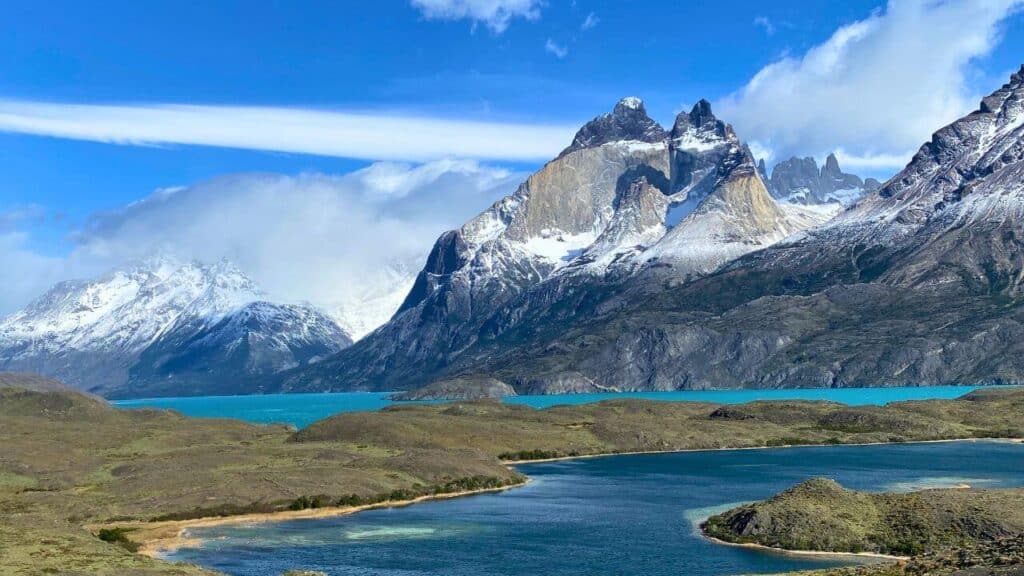
Here’s my detailed W trek guide, which includes everything you need to know if you decide to do the trek independently. Just to note: I started from the west side, saving the Las Torres views for last. However, it’s also possible to start from the east side and see the Torres on the first day.
The O Trek. If you’re looking for more adventure, the O Trek (or The Circuit Trek) is an expansion on the W Trek that will continue onto the Cordillera del Paine over 68 miles (110 kilometers). You’ll get fewer crowds and wilder terrain, where you will spend 6-9 days on the trek in total.
The park regulations state that the O Trek must be hiked counterclockwise (starting at Laguna Amarga). This makes the logistics a lot smoother and acclimatization a lot better before you tackle the pass.
The Q Trek. Do you want to make the most of your time at the park? The Q Trek adds an extra day to the O Trek, starting from the Administration Office and joining Laguna Amarga. There are even fewer hikers here, so enjoy the true solitude.
Day Hikes Torres del Paine
Even if you’re not tackling a multi-day trek, Torres del Paine has plenty of day hikes that deliver jaw-dropping views. So, what are the most popular day hikes in Torres del Paine National Park?
Las Torres (Torres del Paine). The Torres del Paine are three granite monoliths that are the iconic views you will see in photos everywhere. The towers are located in an area known as “Las Torres” (The Towers). They are about 8,222 feet (2,500 meters) above sea level. It’s steep, yes, but reaching the base and seeing Las Torres up close is worth every huff and puff.
French Valley. The French Valley, or Valle del Francés, is part of Torres del Paine’s W trek that offers views of the French Glacier (Glaciar Francés) and Cerro Paine Grande, the highest summit in the Cordillera Paine Range. The trail is 6.2 mi (10 km) long, round-trip, and has incredibly beautiful views of the surrounding mountains. I was constantly stopping for photos, so take that into account when you plan your time there.
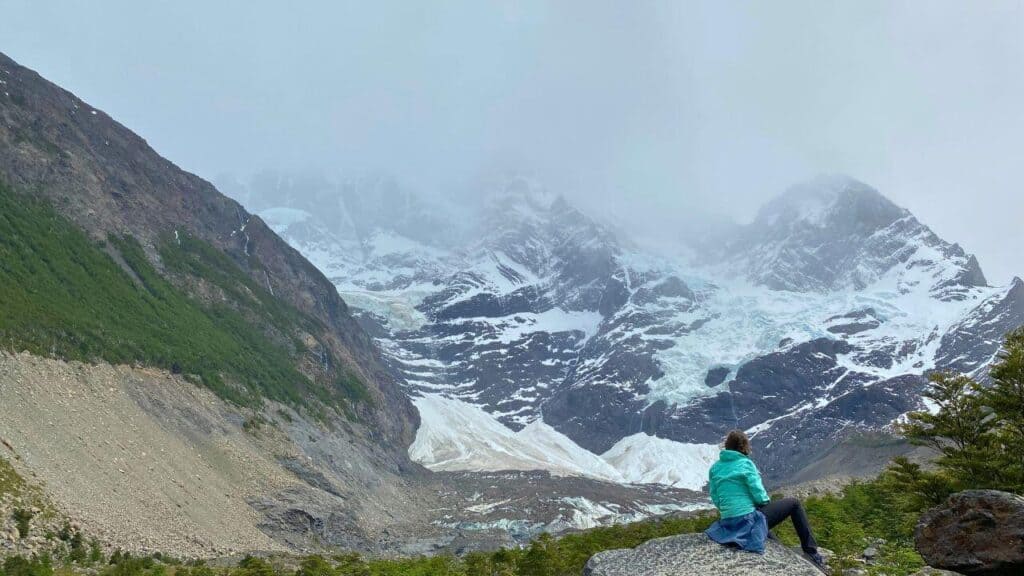
The trail is well-marked, with signs in both English and Spanish. It’s also easy to follow, but be aware that the elevation changes make it a little harder. From Camp Italiano to the Mirador, gaining around 500 m (1,640 ft), but the views make it worth every step.
Fauna Trail. Fauna Trail is a great hike in Torres del Paine National Park and is also known as “Portería-Portería” by hikers. It is a 5-mile (8 km) long trail that leads to some of the most incredible views of the park, and you may see some animals along the trail.
The fauna trail can be done as a day trip, as no camping is allowed along the trail, with plenty of time for a lunch break and taking photos.
Laguna Azul. The Laguna Azul hike is a fun hike in the Torres del Paine National Park, and it’s easy to see why. The trail takes you through a variety of landscapes. It shows you forests and mountains, as well as glacial lakes and fields filled with wildflowers. And when you reach your destination, you’ll be rewarded with views of surrounding peaks.
Laguna Cebolla. If you’re looking for a moderate hike with stunning scenery and a break from the crowds, then Laguna Cebolla is for you. This hike takes about 2-3 hours and has stunning views of the lake, the Torres del Paine massif, and the surrounding mountains. With no other hikers in sight.
It is also an excellent choice if you have time constraints or aren’t quite up for tackling one of the more difficult trails at Torres del Paine National Park. The best thing? You’ll still get the views.
Lago Grey. Lago Grey is one of Patagonia’s popular destinations for hiking. Surrounded by snow-capped mountains and glaciers, the lake’s dark grey waters (hence the name) create a very breathtaking view. You can also see Grey Glacier from a distance while you’re there, it won’t disappoint.
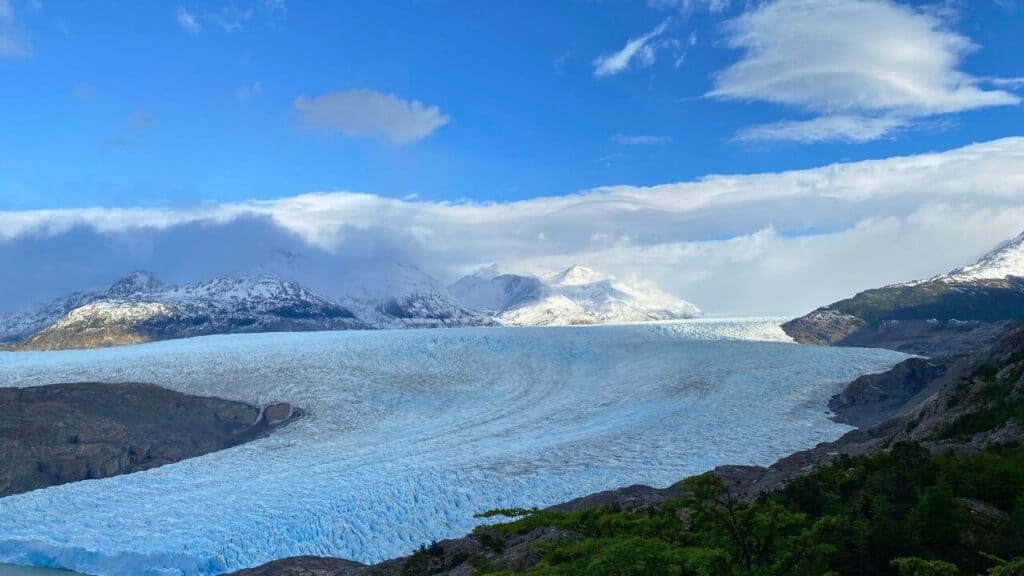
Salto Grande. Salto Grande is a great place to see some of Chile´s spectacular scenery. You will be surrounded by snow-capped peaks, glaciers, and rock formations. The hike is not overly difficult, and it’s more of a viewpoint than a full hike. But you should bring water, as there are no streams or lakes along this route.
Mirador Los Cuernos. The Mirador Los Cuernos hike from Salto Grande takes about 2–3 hours round trip. The trail is fairly easy and flat. The views here are amazing! Do take a wind jacket, as it can get quite windy.
Best Time to Hike Torres del Paine
Summer is the best time to hike Torres del Paine. The weather is generally warmer and more comfortable than during the colder seasons, like winter (June to August), when temperatures drop to 40 degrees Fahrenheit (5°C) during the day.
During summer, from December to March, the weather is generally warmer and more stable. Because this is the most popular season, book in advance to find the accommodation that you’re looking for. I did the W trek in October, in the low season, and we were lucky that there was still availability for all the campsites in July.
How To Get to Torres del Paine
Flying to Puerto Natales
Reaching Torres del Paine is easiest when you fly straight to Puerto Natales. Airlines like LATAM and Sky Airline operate these flights, especially during the high season (December to March). This route saves you time and gets you closer to Torres del Paine National Park in just about 3 hours from Santiago.
Alternatively, you can also fly into Punta Arenas, the main airport of the region. From there, it’s a 3-hour bus ride to Puerto Natales. This is a popular option if flights directly to Puerto Natales aren’t available or if Punta Arenas is part of your itinerary.
From Puerto Natales to Torres del Paine
Once you’re in Puerto Natales, getting to Torres del Paine National Park is pretty straightforward. Buses from Puerto Natales will stop at the main park entrance, Laguna Amarga, where you must register and pay the entrance fee.
For most day hikers and those starting the W Trek from the east (to see the Torres first), this is your stop. The bus continues to Pudeto, which is solely for travelers who need to catch the catamaran across Lake Pehoé to Refugio Paine Grande. This is the starting point for the western leg of the W Trek or for accessing Glacier Grey.
Where To Stay in Torres del Paine
As a visitor, you can choose from various campsites, refugios, and hotels when you visit the Torres del Paine National Park. Book these in advance, as it’s a popular place to be, and the campsites and hotels are fully booked well in advance.
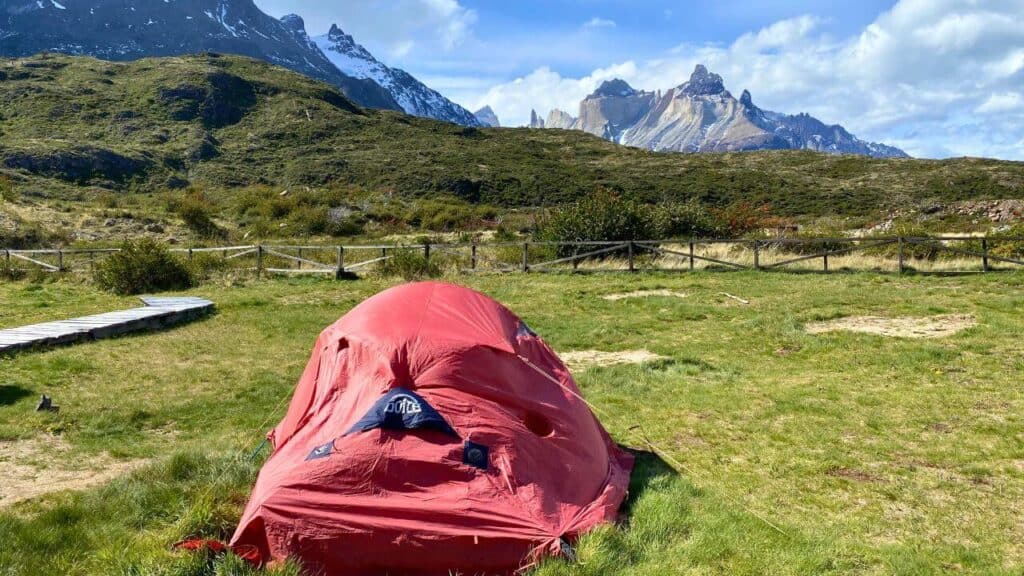
I visited in October (technically, the shoulder season) and quickly booked the campsites in July when I saw there was only one spot left at one of the campsites. Many campsites open their bookings on July 1st for the entire season (October to February). The exact date is announced by the booking concessionaires (Fantástico Sur and Vertice Patagonia) in June.
I can’t stress this enough: ready to book the minute the system opens. I booked my October trip later than that, and got lucky, but many people I met mentioned that their dates were already gone.
Hotel Las Torres
Located in Torres del Paine National Park, Hotel Las Torres offers rooms with stunning panoramas of the park’s mountains. This hotel’s in-house amenities include dining, drinking, and beautiful views. Moreover, it offers a selection of room styles, from basic to opulent, to accommodate travelers with varying budgets.
Hotel Las Torres Patagonia offers accommodations with regular and all-inclusive rates, complete with free Wi-Fi and a complimentary daily breakfast. Rooms are spacious and bright, featuring large windows with breathtaking valley and mountain views, heating, and private bathrooms. Guests can enjoy a generous buffet breakfast, traditional Patagonian dishes at Coirón Restaurant, and a wide selection of beverages and cocktails at Pionero Bar. For those on all-inclusive packages, meals, drinks, and selected excursions are included.
After a day exploring the park, return to the hotel and unwind in the sauna or indulge in beauty treatments at the spa. Guests can also experience life as a Baqueano, or Chilean cowboy, through unique excursions available at the property. With free on-site parking, varied activities, and thoughtful services, Hotel Las Torres ensures a comfortable stay with plenty of amenities to elevate your Patagonian adventure.
Camping
If you want to hike the W Trek or longer routes like the O or Q Trek, camping is the way if you’re on a budget. Along the trails, there are designated campsites where you can stay, most of which require reservations in advance. If you visit during the high season, December to March, spots sell out months in advance.
Even if you visit in the shoulder season, like I did, spots will sell out for the popular camping stops. We visited at the end of October, and almost all camping spots were already sold out in July. So be early.
Campsites typically offer bathrooms with hot showers and a place to cook. A few spots, like Paso and Italiano, have only basic outhouse-style toilets and no showers. The downside of camping is that all equipment must be carried on your back, including tents, sleeping bags, food, and cooking gear. Yes, it’s heavy, but it will save you a lot of money. You can rent your gear in Puerto Natales, it will not be the lightest, but it will do.
There are a few types of campsites:
- Regular Campsite: Set up your tent in a field.
- Platform Campsite: Set up your tent on a raised wooden platform (like at Chileno and Central).
- Full Equipment Rental: Pre-installed tent, mattress, and sleeping bag available for you to rent. The price is higher, but it’s ideal if you don’t want to carry everything.
Refugios
Refugios are simple mountain huts that provide a place to eat and rest for hikers. They offer a choice of bunk-bed dorms or private rooms, and will have a shared bathroom. The good news is that most of these bathrooms have hot water for showers. Along with that, refugios have a restaurant and a lounge area. When booking your refugio, pay attention to whether you still need to bring a sleeping bag. Some of them only provide a bottom sheet.
Prices are higher than camping, but you get the option for meals, a roof over your head, and a bed to sleep in. You can book refugios directly through operators like Fantástico Sur and Vertice Patagonia.
Important Tips for Hiking Torres del Paine
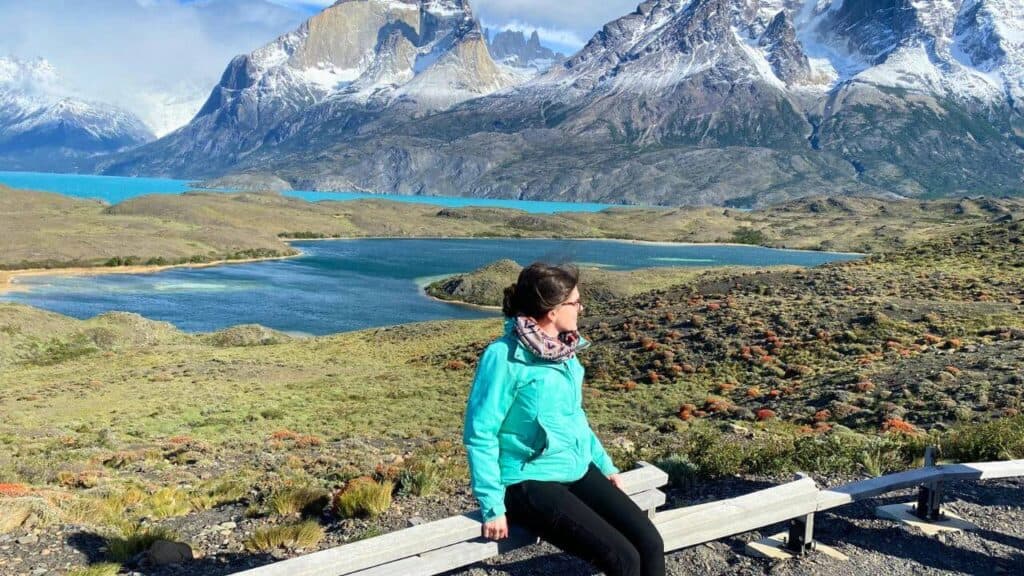
Bring a raincoat. The weather can change quickly, the famous saying that you can experience four seasons in a day is definitely true in the park. A raincoat is always a good idea to have when hiking in Patagonia.
Bring plenty of water and food. The trails can be long and strenuous, so having plenty of water and food is important. You should bring at least one gallon of water per person per day of hiking in Torres del Paine National Park, but know you can fill your Lifestraw or similar water filter system along the way without issues. You will also need to pack a lunch or snacks for the hike if you plan on spending a full day exploring the trails.
Pack a good camera, hat, and sunscreen. You will find that the trails are well-marked and easy to follow, so you won’t need a GPS device. But it is important to pack a good camera because you will want to take plenty of photos of the stunning landscapes and wildlife you encounter on your hike. Bring a hat for shade, sunscreen, and water-resistant clothing if possible.
Wear comfortable shoes suitable for hiking through rough terrain or rock hopping uneven terrain. You should also wear socks that can wick away sweat from your feet during your time hiking in the park.
Protect Your Trip. Consider protecting yourself with travel insurance such as SafetyWing, which can cover medical emergencies, trip cancellations, and other unforeseen incidents during your stay. Use the widget below to snag the perfect policy for your needs and travel with peace of mind knowing you’ve got your back covered, no matter what adventures come your way!
Frequently Asked Questions – Torres del Paine Hiking Guide
Do You Need a Guide to Hike Torres del Paine?
No, you don’t need a guide to hike Torres del Paine in spring and summer. The trails are well-marked, and there will be plenty of hikers along the way. However, if you go in winter, it would be wise to hire a guide. The terrain is challenging and unpredictable, just as the weather.
How Difficult Is Hiking Torres del Paine?
Hiking Torres del Paine is not hard, but it can be a challenge. Depending on what hikes you do in the park, plan time to rest accordingly. You will also want to make sure that you wear proper clothing when hiking so that no one gets injured during their trip.
What Is the Best Time to Hike Torres del Paine?
The best time of year to hike in Torres del Paine is in November or March, in my opinion. During the high season of December to February, there are a lot of people on the trail, and it can get busy. I did the W trek in late October and had an amazing time. It wasn’t too busy or too warm, but the sun was out there and the views were incredible.
Where Is the Best Place to Hike in Torres del Paine National Park?
If you’re up for a multi-day hike, I would highly recommend the W trek. It offers the highlights of the park along with the full hiking experience. It was the longest hike I had done up until that point, but it was incredibly rewarding, and I couldn’t get enough.
Conclusion – Torres del Paine Hiking Guide
Hiking in Torres del Paine is an adventure you’ll never forget. With its glaciers, mountains, and crystal-clear lakes, every trail offers something special, whether you choose a short day hike or a multi-day trek like the W or O. Planning ahead makes the experience smoother, but the magic of the park comes from being out there, taking in the views, and feeling small in such a vast and beautiful place. No matter how long you stay, Torres del Paine will leave you with memories that last a lifetime.
Your Ultimate Laos Travel Guide & Booking Resources
Skyscanner is my trusted ally for booking flights, guiding me to the perfect travel options while making the journey planning process a breeze with its user-friendly interface and extensive search capabilities.
12Go Asia is my ultimate travel companion in Asia, offering the best budget service platform for seamless booking of trains, buses, ferries, and flights, ensuring every adventure unfolds smoothly and effortlessly.
Booking.com is my ultimate lodging partner. It offers many accommodations worldwide and simplifies my travel experiences with its user-friendly platform and unbeatable deals.
Get Your Guide is my go-to for personalized travel experiences, enriching my journeys with unique tours and activities curated to my interests, making every adventure unforgettable and tailored to my preferences.
SafetyWing is my peace of mind on the go, offering comprehensive travel medical insurance with affordable plans and hassle-free claims, ensuring I can explore the world worry-free, knowing I’m protected wherever I roam.
LifeStraw Go Bottle is my trusted hydration companion for outdoor adventures, filtering water on-the-go to keep me safe and hydrated, ensuring every hike or travel experience is worry-free and enjoyable.
If you need more information about the Patagonian region and specific hiking routes, check out these related articles:
- Complete Guide To 15 Most Stunning Patagonia Hiking Trails
- The Best Time To Visit Patagonia: 4 Seasons & Activities To Try
Founder of Spark Nomad, Radical FIRE, Copywriter
Expertise: Personal finance and travel content. I’m a full-time traveler, and I’ve been to 49 countries and 5 continents.
Education: Bachelor of Economics at Radboud University, Master in Finance at Radboud University, Minor in Economics at Chapman University.
Over 200 articles, essays, and short stories published across the web.
Marjolein Dilven is a journalist and founder of Spark Nomad, a travel platform, and Radical FIRE, a personal finance platform. Marjolein has a finance and economics background with a master’s in Finance. She has quit her job to travel the world, documenting her travels on Spark Nomad to help people plan their travels. Marjolein Dilven has written for publications like MSN, Associated Press, CNBC, Town News syndicate, and more.

